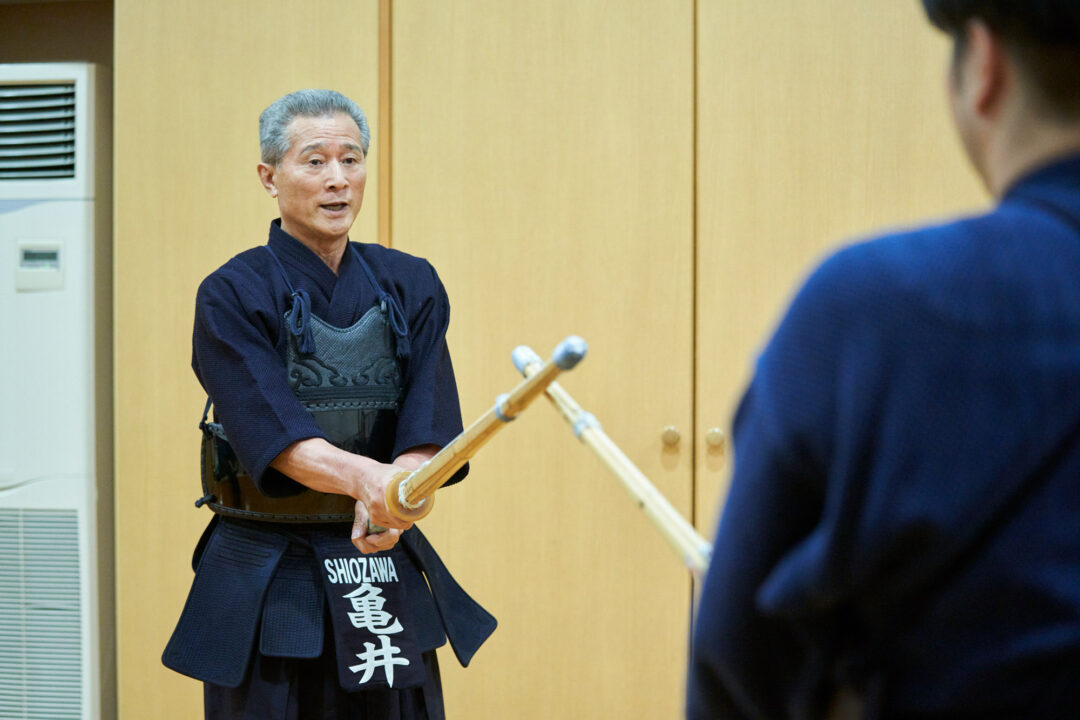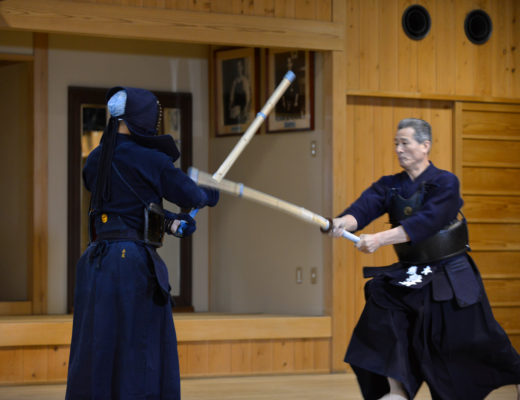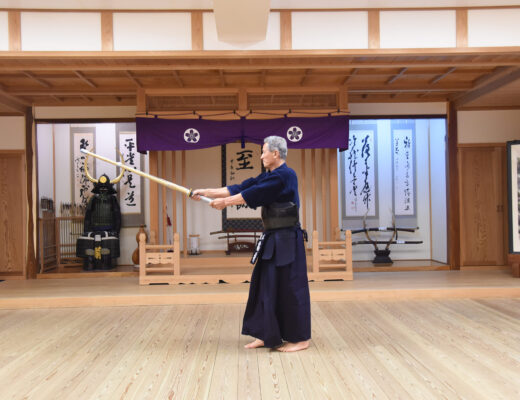2024.10 KENDOJIDAI
Photography: Nishiguchi Kunihiko, Sugino Shinsuke
Translation: Sato Mariko, Pepijn Boomgaard
Kamei Sensei emphasizes, “If your left foot becomes loose, you cannot execute techniques accurately.” To develop proper body movement where the left foot is always functional, it is essential to consistently focus on your left foot during Suburi, Uchikomi, and Kirikaeshi. We asked Kamei Sensei about what he keeps in mind and what he teaches during his instruction.
Kamei Toru, 8th Dan Hanshi
Born in Kumamoto Prefecture in 1954. After graduating from Kyushu Gakuin High School and Meiji University, he joined the Kumamoto Prefectural Police. His major achievements include: 2nd place in the All Japan Kendo Championship, participation in the World Kendo Championships, participation in the All Japan Prefectural Kendo Championship, participation in the All Japan East West Tournament, 1st place in the first division of the National Police Tournament, 1st place in the National Sports Festival, 2nd and 3rd place in the All Japan invitational 8th Dan Championship, 1st place in the All Japan Invitational 7th Dan Kendo Championship in honor of Marume Nagayoshi and winning the Iwate Prefecture 7th Dan Governor’s Cup 3 times.
The judges are watching your left foot and fist.
As noted in the All Japan Kendo Federation’s “Seminar Materials,” mastering Kendo techniques requires striking in one beat. “One beat” means executing a strike without any hesitation. For example, in the case of a Men strike, you prepare, raise the shinai, bring it down, and simultaneously lift and lower your right foot. That’s all there is to it. Of course, there are applied strikes, but the basic concept is the one-beat Men strike, which can be adapted into Kote, Do, or Tsuki depending on the situation.
However, when I ask people to perform a basic Men strike when instructing nowadays, most people first pull their left foot in and then move their right foot forward to strike. It is true that Kendo has a technique called “tsugi-ashi”, where you bring the left foot closer before striking. However, “tsugi-ashi” is used when you are at a long distance. If you are within striking distance, you must strike smoothly without moving the left foot.
The Dan examination evaluates whether your Kendo is appropriate for the rank you are aiming for, assessing overall aspects such as posture, attitude, Seme, and strikes that befit the rank. The foundation of all this is the one-beat strike.
*tsugi-ashi
This method of footwork is mainly used to execute attacks from toi-maai. The left foot (back foot) is moved forward without surpassing the right foot, and followed immediately by a large step out with the right foot.
The judges sit in chairs and observe the candidates’ matches from the side. As the distance closes from the starting position to Shokujin no Maai, Koujin no Maai, and finally Issoku-Itto no Maai, if the left foot collapses, the Seme will not be effective. To strike instantly, it is essential to have your weight on the left foot, but if you lean too far backward, it becomes difficult to execute techniques smoothly. When the desire to strike becomes too strong, there is a tendency to step out only with the right foot, causing your stance to widen excessively. If the left foot collapses, it can also affect your grip on the shinai.
When your foot spacing becomes too wide, it becomes difficult to execute techniques that coordinate your hands and feet. Stiffness and awkwardness result from this lack of coordination. Kendo’s Kamae, with the right foot and right hand forward, is not a natural movement like regular walking, so it must be consciously practiced to master. By using the left foot as the pivot and repeatedly stepping in with the right foot, you can develop a proper rhythm.
Although it seems simple, as we age, our bodies become stiffer, which naturally leads to awkward movements. By consistently practicing Men strikes, Kote strikes, Kote-men strikes, and other practice strikes before Keiko, you can develop a natural and smooth way of striking.
Measure the Distance to Your Opponent with Your Left Foot
The moment I sense an opportunity to strike during the Seme, I commit fully to the strike. I believe that the shorter the transition from stillness to motion, the sharper the strike becomes. A sharp strike occurs with little to no collapse in posture, initiated from the hips and followed through completely.
To execute such a strike in real matches, one must first develop sharp strikes through regular practice. To strike without breaking posture and to initiate from the hips, understanding the appropriate Maai is essential.
When attempting to strike Men from a greater distance, there is a tendency to lean the body forward. While younger practitioners with strong leg muscles may still produce sharp strikes this way, by the time one reaches their 40s and 50s, such an approach often results in merely making contact with the Men without delivering a proper strike.
You gauge the distance to your opponent with your left foot. For a Men strike, the appropriate Maai is about one step back from the opponent’s Men. You’ll come to realize that, to strike a stationary opponent, you need to close the distance much more than you might initially expect.
The basic Issoku-Itto No Maai is the distance where, with one step forward, you can strike your opponent, and with one step back, you can avoid their strike. Since individual differences exist due to factors like age and leg strength, the first step is to understand your own Maai.
In real situations, there is often a tendency to rush and initiate techniques from a much too far distance, resulting in missing the target completely or causing a significant collapse in posture. This is especially problematic during examinations, where a missed strike can be fatal to your performance.
As the Kendo proverb “Under the crossed swords lies hell, but if you step in, all is paradise” suggests, stepping into the Maai with courage and decisiveness, without hesitation, and committing fully to your strike is key to delivering a valid strike.
A Strike with the Left Foot Left Behind is Not Valued
In a Dan examination, you must express yourself within a limited time. The evaluation is comprehensive, assessing whether your Kendo is suitable for the Dan you’re aiming for, but candidates tend to focus on whether they hit the target area or not. While hitting the target is important, the real issue is the quality of the strike.
As shown in Kihon 1 of the “Bokuto Ni Yoru Kendo Kihon Waza Keiko Ho,” a Men strike should be initiated with the right foot and hips, and the left hand should settle in the center of the body when you strike. This same method must be applied when wearing Bogu.
Even if you can execute this technique correctly during basic practice, when striking smaller in real matches, there is often a tendency to lean forward, leave the left foot behind, and change the position of the left hand. If you aim for a high Dan grade, you must master the Men strike initiated with the right foot and hips, paying particular attention to this during your regular basic practice.
What you learn in basic practice should be tested in Ji-geiko, where you can confirm whether you are able to perform the strike you aspire to. A match involves an opponent, so it is not always easy to execute everything according to your intentions.
Dan examinations are especially challenging as they are conducted with opponents of the same rank. It is not uncommon to face candidates you have sparred with in the past. Within this context, it is essential to deliver a perfect, decisive strike.
Training Should Focus on Strengthening the Legs and Hip
A single practice session typically lasts between one to two hours, but the key point to always keep in mind is the strengthening of your legs and hips. The foundation of Kendo lies in the lower body, particularly in the left foot. During basic practice, such as Suburi, Kirikaeshi, and Uchikomi, it is essential to keep the left foot engaged at all times.
When you practice, whether it is body movement, Suburi, Kirikaeshi, Uchikomi, or matched Jigeiko, are you able to maintain the same Kamae consistently? It is very difficult to maintain the same Kamae throughout practice, but once you establish your ideal Kamae, it is crucial to keep that posture stable and unbroken during practice.
I instruct my students that the correct Kamae involves “stretching the thoracic spine (the part of the spine to which the ribs are attached) and tailbone, and maintaining a steady gaze as if you are supporting the ceiling with your head.” Additionally, to create a lively and decisive Kamae that embodies the readiness to strike or thrust at any moment, I recommend distributing the body weight slightly more towards the right foot, with 49.5% on the left foot and 50.5% on the right. This balance is subtle and must be developed through personal experience, but by slightly raising the heel of your right foot and gripping the floor with your right toes, you can create a stance where the left foot’s arch is properly tensioned, ready to strike at any moment.
This stance puts considerable strain on both feet. Because of this strain, there is a tendency to relax the left foot and adopt a more comfortable posture. However, to execute techniques efficiently and effectively when the opportunity arises, this stance is essential. It must be practiced consistently and mastered without fail.
Even though you may intellectually understand that proper body movement and Shinai handling should be centered around the left side of the body (left hand, left hip, and left foot), when the desire to strike without being struck becomes too strong, tension tends to build in the right side of the body. This is especially true with Men strikes—when too much force is applied to the right side, the Shinai takes an over-the-shoulder trajectory, preventing you from striking along the shortest path.
Nowadays, it is easy to record videos using smartphones or other mobile devices. It can be beneficial to record your own Kendo and review it to understand how you are actually performing. You will often notice significant differences between your image of yourself and the reality of your movements.
Additionally, Kendo is not something that can be improved through self-taught methods alone. As you advance in rank and age, the opportunities to seek guidance may decrease, but it is crucial to continuously create opportunities to learn. These days, if you seek it out, learning opportunities are easily accessible. By continuing to practice under the guidance of a proper instructor, correcting your weaknesses, and building on your strengths, you will be able to develop a better and more refined Kendo.




